Protecting Naval Ships From EMP and EMI and the Role of Advanced Cable and Pipe Transits
Protecting Naval Ships From EMP and EMI
Electronic Warfare – A Current Reality
Enhancing Safety and Security in Naval Vessels
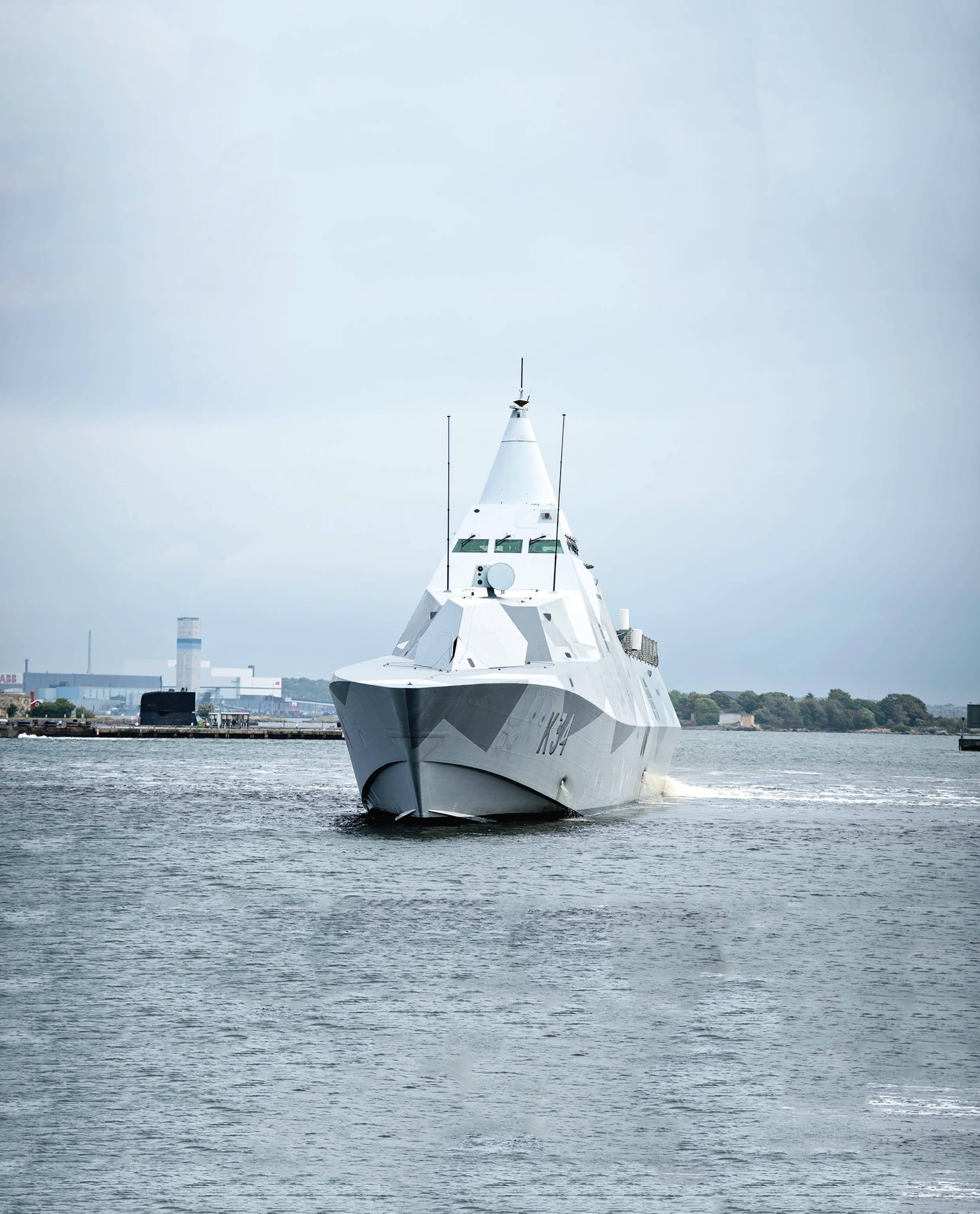
Safeguarding Information and Communication
Looking to the Future
Published by Global Business Media
TECHNICAL STUDY
United Kingdom
Switchboard: +44 (0)1737 850 939




Fax: +44 (0)1737 851 952
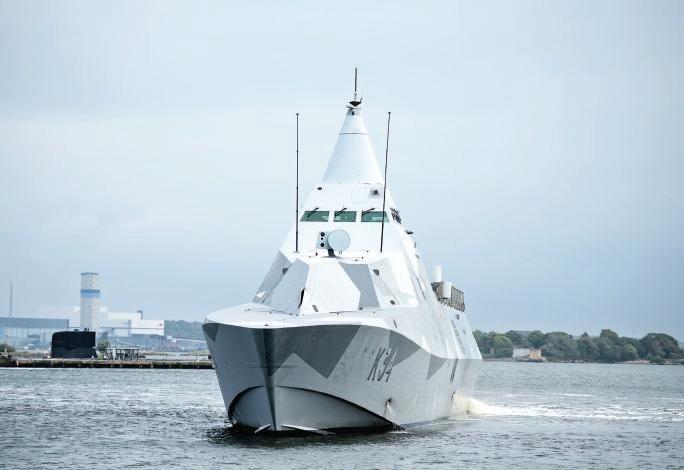
Email: info@globalbusinessmedia.org
Website: www.globalbusinessmedia.org
Publisher
Global Business Media
Senior Analyst
Martin Richards
Editor
John Hancock
Project Manager
Paul Davies
For further information visit: www.globalbusinessmedia.org
The opinions and views expressed in the editorial content in this publication are those of the authors alone and do not necessarily represent the views of any organisation with which they may be associated.
The views and opinions expressed in this publication do not necessarily express the views of the Publishers or the Editor.
While every care has been taken in the preparation of this publication, neither the Publishers nor the Editor are responsible for such opinions and views or for any inaccuracies in the articles.
© 2023. The entire contents of this publication are protected by copyright. Full details are available from the Publishers. All rights reserved. No part of this publication may be reproduced, stored in a retrieval system or transmitted in any form or by any means, electronic, mechanical photocopying, recording or otherwise, without the prior permission of the copyright owner.
PROTECTING NAVAL SHIPS FROM EMP AND EMI
Published by Global Business Media Global Business Media Limited 62 The Street Ashtead Surrey KT21 1AT
Contents Protecting Naval Ships From EMP and EMI and the Role of Advanced Cable and Pipe Transits Published by Global Business Media Protecting Naval Ships From EMP and EMI Electronic Warfare – A Current Reality Enhancing Safety and Security in Naval Vessels Safeguarding Information and Communication Looking to the Future TECHNICAL STUDY WWW.GLOBALBUSINESSMEDIA.ORG Introduction 1 John Hancock, Editor Protecting Naval Ships From 3 Electromagnetic Pulses and Interference Mikael Grudd, Technical Product Manager/Electro Magnetic Specialist, Roxtec Ltd Background Electromagnetic Compatibility Electromagnetic Disturbances and Interference Solutions For Naval Vessels Fibre Optic Shielding HEMP – Protecting Naval Ships’ Functionality and Operability Case Study Roxtec Background Electronic Warfare – A Current Reality 6 John Hancock, Editor A Range of Capabilities The Priorities of Electronic and Electromagnetic Warfare Conducting Electronic Warfare Today Enhancing Safety and Security in Naval Vessels 8 Camilla Slade, Correspondent Vulnerabilities of Naval Vessels Protecting Sensitive and Security Systems Command Control Room, the Heart of the Naval Vessel Safeguarding Information and Communication 10 Peter Dunwell, Correspondent Communications Cyber Security Defence of the Ship Looking to the Future 12 John Hancock, Editor
Threats and
Future
Responses Being Ready for Anything
Everything Is Vital: Everything is a Target
Warships
Tomorrow? The Systems Themselves Need to be Secure References 14
How Will
Look
Introduction
The Protection of Key Systems on Naval Vessels
With the current furore around artificial intelligence and the risks from data theft, many people are waking up for the first time to the new reality of a world in which data and electronic systems are pre-eminent in every walk of life but are also vulnerable to threats. For those involved in naval warfare, those threats are potentially existential. That is why it is so important for systems and all of the equipment that support them to offer no points of weakness that an intruder could exploit. In this Report, we consider a number of the environments and activities that relate to the capabilities, supporting systems and vulnerabilities of naval vessel electronic warfare plus some of the things that aim to safeguard them from attack and compromising.
We open with an article from Roxtec Ltd, a leading company specializing in the development and manufacture of cable and pipe seals, which very clearly explains how to protect naval ships against electromagnetic and other threats to critical systems, considering the nature of those threats and how to shield cables and equipment at points of vulnerability such as when passing into and out of protected areas. Our next article looks at the overall matter of electronic warfare, what it is capable of doing, and where it can be vulnerable to intrusion or interception. We also
look at the priorities that underpin how electronic warfare is conducted and how safeguarding the systems themselves is as important as conducting operations. Camilla Slade’ article looks at the issue of safety and security in navy vessels starting with vulnerabilities. She then considers protection of sensitive and security systems before looking at the command control centre which is nowadays at the heart of navy ship systems and is, therefore, a high value target for electronic as well as physical attacks. In his article, Peter Dunwell brings the focus right down to information and communications or, more specifically, the safeguarding of those elements. As part of that, he looks at cyber security and, most importantly, at defence of the ship - the platform on which the whole system is housed. Finally, we look to the future. We consider future threats and potential responses, the need to be ready for everything and the reality that everything of value for a navy ship is a target. Ships of the future (and of the present) are looked at and we re-iterate that the systems that underpin the modern naval vessels need themselves to be protected.
John Hancock Editor
John Hancock joined as Editor of Defence Reports in early 2012. A journalist for more than thirty years, John has written and edited articles and papers on a range of defence, engineering and technology topics as well as for key events in the sector. Subjects have included naval engineering, testing, IT, materials engineering, weapons research, supply chain, logistics and aero-engineering.
PROTECTING NAVAL SHIPS FROM EMP AND EMI WWW.GLOBALBUSINESSMEDIA.ORG | 1
Protecting Naval Ships From Electromagnetic Pulses and Interference
Mikael Grudd, Technical Product Manager/Electro Magnetic Specialist, Roxtec Ltd

Electromagnetic pulses and electromagnetic interference or electrical noise are a key concern aboard naval ships. Roxtec’s pioneering safety seals are gaining attention in the naval industry for their ability to help withstand EMI more effectively than any other seal presently on the market – it works for both conventional shielded cables and fibre optic cables.
EMI is a prime issue because of the highly sensitive and advanced nature of the technology onboard naval ships which means a higher risk of problems caused by EMI.
Background
Electromagnetic Compatibility
EMC is the ability of electrical or electronic devices to function properly in their intended electromagnetic environment, without introducing unwanted electromagnetic disturbance. EMC is a measure of quality and the margins for immunity and emission. It tells how well a device cooperates with other devices, electrically. Several international standards define aspects of EMC.
Electromagnetic Disturbances and Interference
Electromagnetic disturbances can be caused by various natural phenomena such as sun storms
or northern lights. Cell phones and everyday electronics can also affect sensitive electronic equipment in a negative way, and vice versa. There are also undesired electromagnetic fields which can be the result of discharge of static electricity, sparks from switches, electronic warfare or acts of terrorism. If the disturbance is powerful enough to cause a negative impact on the system performance, it is called EMI.
Solutions For Naval Vessels
With proven products for electromagnetic shielding, you can minimize the risk of malfunctions and failures on a naval vessel. Using the Roxtec ES sealing solution ensures naval ships can protect against both EMP and EMI. The system is approved by all major classification societies. Roxtec ES seals provide electromagnetic shielding as well as certified protection against fire, gas and water.
Areas of naval vessels where Roxtec cable transits are installed include the command control room, where it ensures electromagnetic shielding and protection of equipment. The compact, area efficient seals further ensure EMP/ EMI protection of cabinets and enclosures and make it possible to reduce the size of cabinets, junction boxes and other enclosures as well as to reduce engineering hours spent on cable data and cable gland configurations. Roxtec seals are also used in the communication area of navy ships covering crypto and sonar, where Roxtec cable and pipe transits ensure electromagnetic shielding both inside, and around the rooms. The Roxtec ES solutions work by protecting equipment and creating an internal barrier for sensitive information.
Roxtec Technical Product Manager and Electromagnetic Specialist Mr Mikael Grudd explained the primary purposes of shielding.
“Our shielding solution is concerned with two prime areas,” he said. “First you want to
PROTECTING NAVAL SHIPS FROM EMP AND EMI 2 | WWW.GLOBALBUSINESSMEDIA.ORG
The Roxtec ES solutions work by protecting equipment and creating an internal barrier for sensitive information
MIKAEL GRUDD, ROXTEC TECHNICAL PRODUCT MANAGER AND ELECTROMAGNETIC SPECIALIST
reduce the self-generated electromagnetic noise. There could be several reasons but minimizing the ship’s signature is essential. Also, for signal intelligence ships, it is very important as they are listening to signals far away and you need to be able to differentiate them from the background noise. Therefore, your own disturbances must be kept to a minimum which Roxtec seals do.
“Secondly, you want to ensure your sensitive electronics are not disturbed or, in worst case, permanently destroyed. This would be catastrophic for the ship’s ability to operate and defend itself. So, say in the instance of an electromagnetic weapon or nuclear explosion, you do not want your control systems to go down with a very strong EMI pulse. In this instance the energy level is so high the circuits will
be permanently destroyed. How do you protect from this? We encapsulate the electronics in a shielded area with a metallic or highly electrically conductive barrier surrounding it on all sides. To be able to access the electronics on the inside, cables and pipes need to be routed through the barrier requiring an opening. The opening is a puncturing of the electromagnetic barrier and weakens the protection if left unattended. Using a Roxtec ES solution, the barrier is recreated by the built-in electrically conductive rubber barrier inside the sealing solution. Key is ensuring the cables do not act as an antenna for EMI and make the situation worse. The Roxtec ES sealing solution restores the electromagnetic protection and, at the same time, allows cables and pipes to be routed for power, signals and cooling. Roxtec ES solutions efficiently divert disturbances from the shielded cables and via the built-in electric barrier within our modulesthey also prevent radiated disturbance.
“We want to make the cables and pipes a part of the wall, electrically speaking. We replace metal removed from the wall inside with our solution, effectively repairing the wall. We route cables through the barrier but maintain its electromagnetic performance. This ensures the ship’s electrics do not malfunction and continue to perform all their vital roles powering equipment.”
Mr Grudd said the shielding works by reducing electromagnetic signals and blocking the field with barriers made of electrically conductive or magnetic materials.
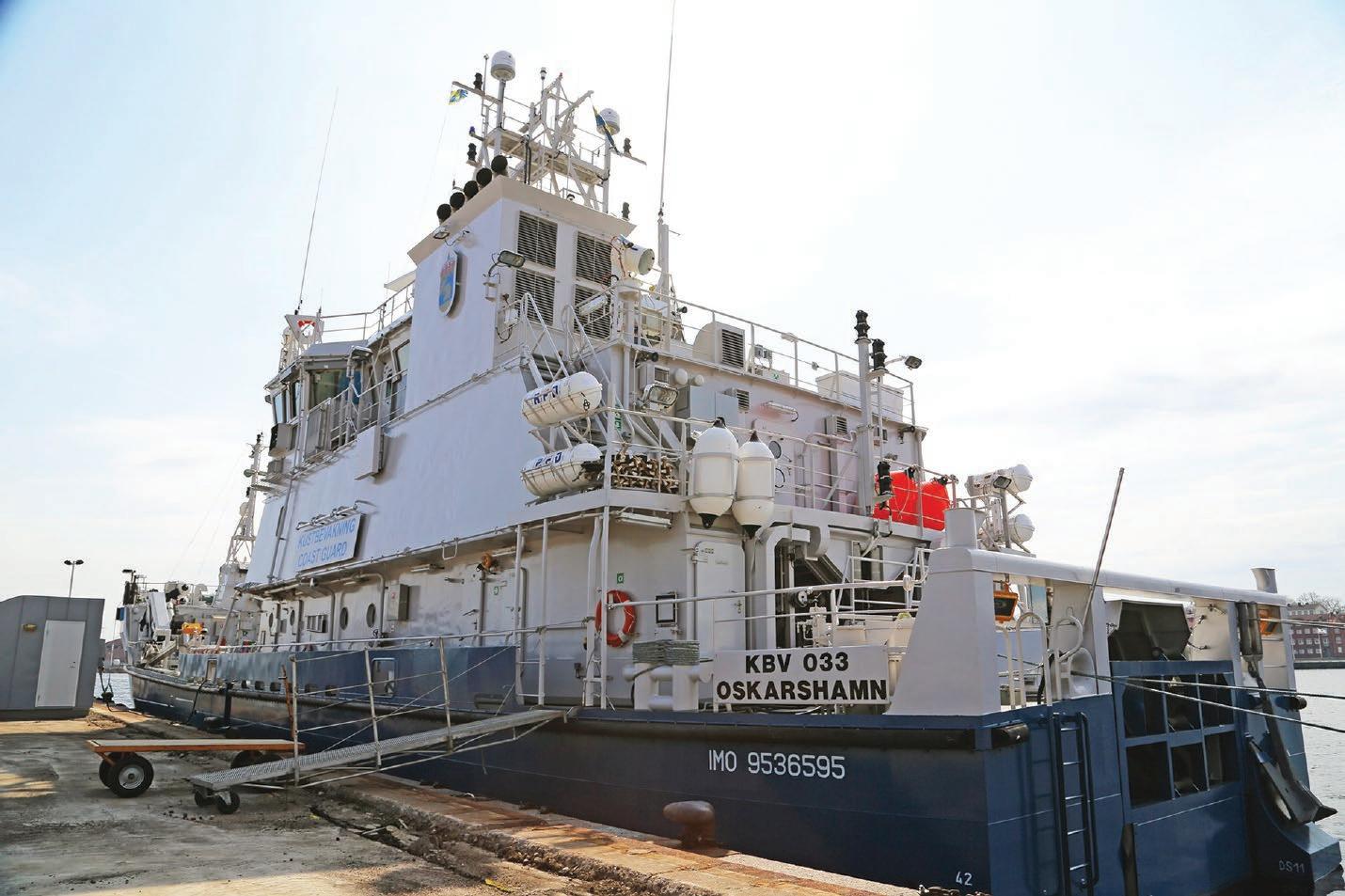
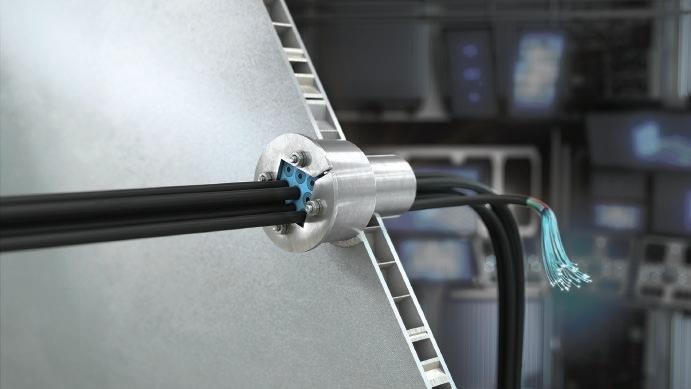
“Shielding also works the other way round,” he said. “It prevents electromagnetic signals and fields from leaving a shielded area. You can protect sensitive information from wiretapping or keep disturbances generated by power

PROTECTING NAVAL SHIPS FROM EMP AND EMI WWW.GLOBALBUSINESSMEDIA.ORG | 3
The Roxtec ES system provides an effective protection when used in shielded environments. The system both diverts conducted disturbances and shields against radiated disturbances
SWEDISH COAST GUARD VESSEL
ROXTEC EMC TRANSIT ONBOARD SWEDISH COAST GUARD VESSEL
ROXTEC WAVEGUIDE SEAL ES FOR FIBRE OPTIC CABLES
pulses. This is an industry first generation inside a shielded area to ensure emission limits.
“All electrical and electronic equipment are sources of electromagnetic disturbance, which means they have the potential to cause problems in other devices. They can also be affected by electrical interference, which means they are receptors as well.”
Common sources
• Radio, TV and radar equipment
• Electric power lines
• Electronic circuits
• Light dimmers
• Arc welders
• Electric motors
• Electric storms and large solar flames
• Electromagnetic pulse weapons
Receptors (potential victims)
• Radio and TV receivers
• Appliances
• Computers
• Electronics
Eliminate the coupling paths
• Sources and receptors are no problem as long as they are not electrically connected.
You can achieve protection against electromagnetic threats through elimination of the coupling path, which is the connection that transfers the disturbance from the source to the receptor/victim.
The Roxtec ES system provides an effective protection when used in shielded environments. The system both diverts conducted disturbances and shields against radiated disturbances.
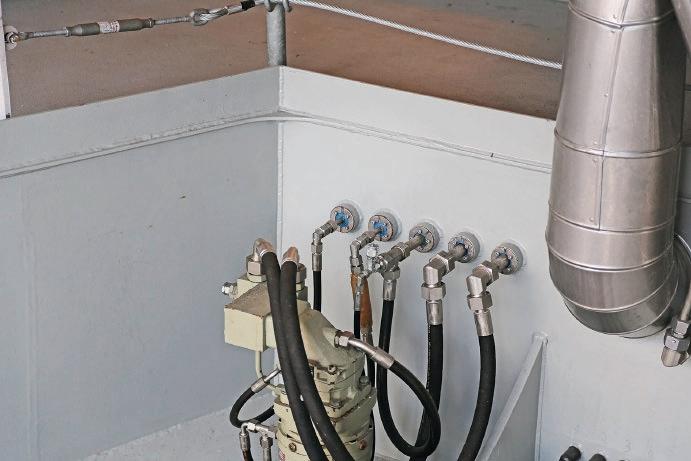
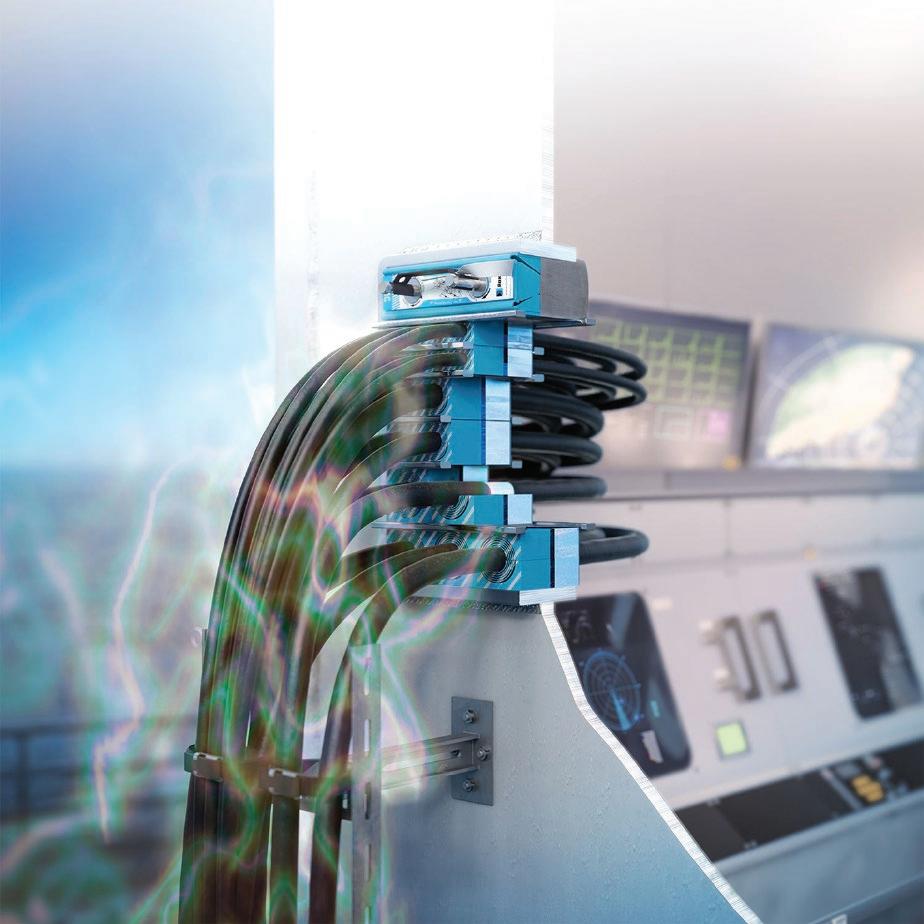
Conducted coupling path – the electromagnetic disturbance travels via cables, shields and metallic pipes. The coupling path could be either inductive magnetic coupling or capacitive electrical coupling.
Radiated coupling path – the electromagnetic disturbance travels via air as an electromagnetic wave. Its energy is absorbed and generates a current flow in the receiving cable/pipe or directly in the electronics.
Mr Grudd continued: “At the Roxtec electromagnetic test lab, engineers and technicians use shielded rooms, antennas, transmitters, and receivers to verify the ability of the seals regarding the reduction of the electrical field strength, known as attenuation, of radiated interferences. The shielding performance can be evaluated in a frequency range covering even the toughest requirements. Roxtec ES modules have a conductive rubber layer that attenuates electromagnetic disturbances and forms an efficient barrier against radiated EMI.
“The attenuation level of the seals is presented for easy evaluation and comparison for use in the product development process. The results clearly present the shielding performance of the seals when it comes to protecting the point of entry and forming a complete shielded solution for naval vessels.”
Fibre Optic Shielding
Roxtec has recently developed a penetration seal for electromagnetic shielding to be used with non-metallic fibre optic cables, known as the Roxtec Waveguide Seal ES. Fibre optic cables are becoming increasingly common in naval vessels for their efficiency. One single fibre optic strand can carry ten times as much data as an ordinary ethernet cable. In addition, one fibre optic cable can accommodate hundreds of fibre strands and thereby replace thousands of ethernet cables thus streamlining the installation according to Mr Grudd.
“The more modern the ship, the more fibre optics we see,” he said. “Ship designers want more fibre optics to improve installation time and keep down the ship’s electromagnetic signature, as fibre optics do not generate any electromagnetic signature.”
The Roxtec Waveguide Seal ES is designed
PROTECTING NAVAL SHIPS FROM EMP AND EMI 4 | WWW.GLOBALBUSINESSMEDIA.ORG
Our lab has proved Roxtec seals provide protection for fibre optic cable entries from water, gas, fire and electromagnetic
ROXTEC EMC CABLE TRANSIT
ROXTEC PIPE TRANSITS ONBOARD SWEDISH COAST GUARD VESSEL
for routing non-metallic fibre optic cables into a shielded enclosure while maintaining the enclosure’s electromagnetic integrity. The waveguide seal protects electronics from electromagnetic threats such as EMP and HEMP (see below). The solution offers both environmental protection and electromagnetic shielding in a single seal. It is a high-performance product, based on a waveguide technique, offering minimum 100dB shielding effectiveness.
“Very few ships in the world need this 100dB level which is extremely high, so this is exceptionally robust protection,” said Mr Grudd. “In addition, very few of our competitors offer this electromagnetic protection combined with water, gas and fire protection. We have all these features in one seal which no other company presently does. Most other solutions provide protection from fire, gas and water but do not protect fibre optic cable entries from electromagnetic interference. Our lab has proved Roxtec seals provide protection for fibre optic cable entries from water, gas, fire and electromagnetic pulses. This is an industry first.”
HEMP – Protecting Naval Ships’ Functionality and Operability
HEMP is an immensely powerful well known cold war weapon. HEMP is a high-altitude electromagnetic pulse, created through a nuclear weapon detonation, tens of kilometers or more from the surface of the earth. The distance is chosen depending on target area and desired disastrous effect. The effects of a HEMP attack are a total disaster for the electrical power grid and other critical infrastructure. It makes transformers overheat and explode – and can blow away the entire power grid. The electricity supply goes down and all modern electronics, including computers, communication systems and systems in cars and aircraft, in a very vast area risk severe damage in just a few seconds.
“HEMP is being talked about more,” says Mr Grudd. “The war in Ukraine as well as nuclear tests undertaken by North Korea are bringing the HEMP threat into sharper focus. Navies are very interested in how Roxtec can protect their vessels as they want their warships to remain fully functional even if they are located close to the initial attack. The ships may be the last line of defence and are not allowed to fail regardless of the effects of HEMP.”
Case Study
The EMC capability of Roxtec’s transit seals is a crucial consideration onboard four vessels belonging to the Swedish Coast Guard. Here, the transits for single and multiple cables and pipes are used to ensure electromagnetic compatibility on the vessels which are carrying sophisticated
electronic equipment. The KBV 033 vessels are built to handle oil spill, fire-fighting and search and rescue as well as maritime surveillance, fishing control and environmental protection. The need for safe, reliable and flexible transits is omnipresent.
The German shipyard, P+S, selected Roxtec SRC transits for the vessels. The transits were manufactured with special EMC modules with rounded corners to reduce stress around exposed bulkheads and minimize the risk of damage to the structure. This enables the Roxtec EMC system to protect the radar and antennas on upper deck against electromagnetic interference.
The Roxtec seals’ versatility was a prime factor in Roxtec being specified. As well as providing EMC protection, the seals further offer protection against water, gas and fire.
Roxtec Background
Roxtec was founded in Sweden in 1990. It is now the global leader in the manufacture of innovative modular-based cable and pipe transit systems, supplying many of the world’s biggest firms. It is active in more than 80 markets with a turnover of more than £198million employing over 800 staff across 28 subsidiaries.
One of Roxtec’s biggest sectors is marine, and the company supplies cable and pipe transits for multiple demands to many of the leading navies around the world.
Roxtec seals are further extensively specified on merchant vessels such as tankers, container and cargo ships, cruise ships and ferries as well as superyachts and OSVs.
Today Roxtec has more than 300 registered product certificates and over 500 registered tests and approvals.
Contact Roxtec Ltd
Write: Unit C 1, Waterfold Business Park, Bury BL9 7BQ Lancashire
Call: +44 161 7615280
Email: uk-market@roxtec.com
Visit: www.roxtec.com
PROTECTING NAVAL SHIPS FROM EMP AND EMI WWW.GLOBALBUSINESSMEDIA.ORG | 5
Navies are very interested in how Roxtec can protect their vessels as they want their warships to remain fully functional even if they are located close to the initial attack
Electronic Warfare –A Current Reality
John Hancock Editor
The equipment for an all-round capability needs all round protection from interception
What first engages our imagination as Science Fiction can become reality within the span of a lifetime. The wristwatch size device worn in the television series, Star Trek and regarded, in the 1960s, as improbable, is now a popular Smart device that can not only communicate but also monitor body functions and organize our working day. Electronic warfare in a similar, though not parallel, manner has become a reality of growing importance in modern conflict. But it isn’t that new.
During World War II, Radar started to alert us to incoming enemy aircraft and signals interception was a vital tool with which to gather intelligence and to feed false information to the enemy. Equally, countermeasures were already developed using encryption to make it difficult to read what was intercepted. At Bletchley Park, the process of decryption, code breaking, was enhanced with the development, in 1943, of what is commonly regarded as the world’s first programmable computer, Colossus. And one of the great breakthroughs in the war was the Royal Navy’s recovery of German Enigma coding and de-coding machines, with captured German U-boats in 1941, an early case getting into the enemy’s systems. Much of electronic warfare is about cracking the other sides system but it is also about protecting one’s own systems – a key theme in this Report.
A Range of Capabilities
No longer the ‘Ray Gun’ of Sci-Fi, electronic warfare is now a sophisticated and vital component of war fighting that experts break down into several areas of activity. Most wars today see electronic capabilities deployed, either directly or through the support of allies. Currently, Ukraine’s ability to defend itself from attacks makes heavy use of intelligence supplied from the systems of supporting countries. It isn’t only the ability to spot incoming threats in time to deploy defensive measures or to attack and disable the enemy’s fighting systems,
although they remain important objectives for electronic warfare. Attacks, these days, are as likely to be electronic as physical and so there is also a need to protect one’s own electronic equipment against those. As BAE Systems explains, “Threats are evolving at a rapid pace, with adversaries attacking in ways never seen before.”1 There is also still the need to support military actions with the most intelligence and capability and to disable the enemy’s electronic capabilities, including electronic warfare capability. Technological advances have added capability to electronic warfare but have also introduced further vulnerabilities with so much being carried over and stored on electronic systems; the need to protect those systems is a growing part of electronic warfare capability.
Electronic warfare might be summarized as attacking an enemy, protecting your own and allies’ military and infrastructure, and providing situational awareness for those engaged on the mission. Much of modern electronic warfare activity might also be described as electromagnetic warfare in which electromagnetic protection is a critical component. However, while the warfare might be conducted electronically, it does require equipment such as transmitters and receivers as well as the means to manage signals intelligence (SIGINT), electronic intelligence (ELINT), and communications intelligence (COMINT) as well as jamming systems. It all needs cabling to link to the theatre of war and that can be a source of weakness if not properly protected.
In a world where we are growing ever more used to electronics and cyber environments, NATO2 explains that, “EW [electronic warfare] should not be confused with cyber warfare and capabilities. Broadly speaking, cyber operations use various hacking techniques to infiltrate and disrupt a target’s computer systems, in order to obtain intelligence or degrade the target’s capabilities. EW uses directed energy to cut
PROTECTING NAVAL SHIPS FROM EMP AND EMI 6 | WWW.GLOBALBUSINESSMEDIA.ORG
Much of electronic warfare is about cracking the other sides system but it is also about protecting one’s own systems
off access to the electromagnetic spectrum, blocking signals between technologies and rendering them inoperable. Of course, by interfering with computer infrastructure, EW can affect operations in the cyber domain.”
As mentioned above, attacks, these days, are as likely to be electronic as physical and, as L Harris ‘Understanding Electronic Warfare’3 explains, “Electronic attack may be used to deny an adversary’s ability to communicate, navigate, gather intelligence or locate targets on the battlefield.” A significant part of this is to disrupt communications which often means getting at the cabling and processing systems.
The Priorities of Electronic and Electromagnetic Warfare
In essence, the priorities of electronic warfare are to damage the enemy’s ability to attack by interfering with the electronics that will guide any attack, to support your own ability to attack, and to intercept and disrupt the enemy’s communications while maintaining and protecting your own communications. This element of electronic warfare is so important that Cranfield University in the UK runs a course, ‘Communications – Electronic Warefare’4 which aims to equip graduates to…
• Identify the main electronic surveillance (ES) and electronic attack threats (EA) to a communications system and propose defensive measures to reduce the impact of these threat,
• Explain the main analysis methods employed in communications EW in the time, spectral and spatial domains,
• Analyze and evaluate the impact of electronic attack on a communications network using a power budget and quantify the effect of electronic defense measures.
Conducting Electronic Warfare Today
So far, we’ve considered electronic warfare from a more academic point of view but, today, we face real and current threats. Global Defence Technology 5 quoting GlobalData Analysts explains that “The demand for electronic warfare (EW) products will be driven by their universal application… heavily driven by Russian capabilities and increased Chinese aggression.” We are entering a period of a less stable and more threatening global order in which those fighting wars will employ every type of warfare with an increasing emphasis on electronic warfare of all types in a process known as spectrum warfare. In spectrum warfare, protagonists combine a range of technologies, including electronic jamming and interception, radar, electronic deception, electro-optical technologies, sensors, visible-light sensors and laser technologies.
They all rely on highly sophisticated equipment and often physical communications and that all poses the challenge of protection against the other side’s spectrum warfare activities, often using secure cabinets which also means ensuring that secure storage really is secure, including where cables and pipes have to pass through the wall of the storage.

PROTECTING NAVAL SHIPS FROM EMP AND EMI WWW.GLOBALBUSINESSMEDIA.ORG | 7
While the warfare might be conducted electronically, it does require equipment such as transmitters and receivers as well as the means to manage signals intelligence (SIGINT), electronic intelligence (ELINT), and communications intelligence (COMINT)
A NUCLEAR SUBMARINE DEPARTS A HARBOUR
Enhancing Safety and Security in Naval Vessels
Camilla Slade, Correspondent
To optimise effectiveness, the various systems need themselves to be protected from intrusion and interception
Military forces are not discreet units undertaking their own actions in isolation from other forces. Land, air and naval forces are all components in a unified infrastructure whose effectiveness depends very much on the interoperability of the different components and that means that there have to be communications connecting them all. Communications devices and systems are often points of vulnerability in any infrastructure, including defense.
Vulnerabilities of Naval Vessels
Some of the vulnerabilities of naval vessels are the same as with any ship. In his article for Lloyd’s List, ‘Ethical hacker says ships are wide open to cyberattack’6, Declan Bush explains the multitude of potential access points when someone with illintent could break into a system to read what was there. It is incumbent on any operator of ships, including naval vessels, to identify and close potential weak spots or gaps in their electronic security and, of course, to implement processes and conventions to maintain that security. More specifically looking at naval vessels, Dr Moeen Ahmed Mahmoud, writing for Aljundi, ‘Electronic Warfare on Warships; threats and countermeasures’7 explains that, “… the presence of long-range and accurate surveillance devices exacerbates the [limits on ship movements], by preventing the discreet movement of fleets... Therefore, ships [have] to be equipped with sensors that can provide early warning for any possible attack, as well as defensive or offensive equipment with a longer range than any potential threat.” Although cyber and electronic warfare are not the same, it could be through a breach in electronic protection that a cyber attacker can get into a ship’s systems.
Protecting Sensitive and Security Systems
To avoid that risk, sensitive functions and equipment on board naval vessels are housed in secure enclosures built with materials that can protect electrical equipment from physical
or environmental damage (fire, smoke, water, gas, vibration…) but can also provide protection against electromagnetic or radio frequency interference. That said, protective enclosures have to be connected to the outside world for power, communications, cooling, air-conditioning and other services and that means that there have to be points of entry for those services, cable and pipe transits, which is where security is at risk of being breached.
To counteract such potential for security breaches, cable transit systems have been developed to allow a protective enclosure wall to let cables through but without compromising the enclosure’s integrity. Cable transit systems offer protection against the threats highlighted above as well as vermin which could damage the equipment. The best cable transit systems will protect against fire, water, smoke, vibration, temperature changes and, importantly, threats to sensitive equipment. They provide data security and ensure that functionality is not breached. The shielding properties in cable transit systems protect against electromagnetic interference (EMI) or radio frequency interference (RFI) entering the enclosure through the cable transit.
Another important part of maintaining security is cable management. In any application, it is important to segregate power and data cables, as power cables can cause electromagnetic interference which will compromise data. More than even in a civilian application, cable management is critical for naval vessels where, as well as for routine maintenance, it might be necessary at short notice to repair or reconfigure equipment or re-route cables in order to retain the ship’s full fighting capacity even when damage has been sustained. Also, poorly managed cables can become a hazard as well as restricting airconditioning and cooling systems, vital for human health and equipment safety. While there will be cases where the additional protection provided by a good cable transit is part of an upgrade, according to Sree Potluri, writing in Control Engineering8, ‘the best cable management
PROTECTING NAVAL SHIPS FROM EMP AND EMI 8 | WWW.GLOBALBUSINESSMEDIA.ORG
It is incumbent on any operator of ships, including naval vessels, to identify and close potential weak spots or gaps in their electronic security and, of course, to implement processes and conventions to maintain that security
strategy is foresight in selecting components’ “… ignoring the effects of required cabling until the end of the design process increases expenses and overall equipment footprint.” That would include the selection of the right cable transit system from the outset.
Command Control Room, the Heart of the Naval Vessel Naval vessels, although they will be connected for most of the time with headquarters, major decisions about the assets under the commander’s command and co-ordinated movements with allied forces have to be made onboard the ship. The capability to support such decisions resides in the Combat Information Center or the Command Information Center, a room on a warship that functions as a tactical center, collecting, processing and providing command and control information to battle command staff for operational units in the near battlespace or wider area of operations. In any Control Center, there will a high density of sophisticated but also vulnerable equipment and cabling.
Command Information Centers have the same function: collecting, processing and providing command and control information to decision makers whether it is to a president, prime minister, general, or local forces. The way in which information is collected and the communications systems used may be different
from unit to unit, but the purpose to provide clear situational information and available options to the commander remain the same whether the CIC is located on a submarine, surface ship, or airplane. Some control, assistance, and coordination functions, such as prioritization of sensor resources including radar, targeting, or communications, might be handled by the CIC staff or by the CIC officer.
Given its complexity and importance, the Command Information Center, contains a number of functions that an enemy would seek to intercept, disrupt or damage. Fighting, defense, vessel management and communications systems are all vulnerable and so need optimum protection and shielding to ensure their security against electronic or cyber-attack.
Electronic warfare is a priority for all modern navies. Military + Aerospace Electronics’ article, ‘Royal Navy to boost electronic warfare (EW), antiship missile defense capability on U.K. surface warships’9 reported in 2021 that the UK MoD had, “… awarded a 100-million-pound contract through Defence Equipment and Support (DES) to deliver electronic warfare (EW) to [the] Royal Navy [as the] first phase of a 500-million-pound program to further equip frigates and aircraft carriers with EW capability.” The objective is to improve the simultaneous detection and identification of radar signals over a greater frequency range than current capabilities. Those capabilities will, themselves, need to be shielded.

PROTECTING NAVAL SHIPS FROM EMP AND EMI WWW.GLOBALBUSINESSMEDIA.ORG | 9
The Command Information Center, contains a number of functions that an enemy would seek to intercept, disrupt or damage.
Fighting, defense, vessel management and communications systems are all vulnerable
F361 IVER HUITFELDT FRIGATE FROM THE DANISH NAVY
Safeguarding Information and Communication
Peter Dunwell, Staff Writer
As important as reading the enemy’s communications and information is safeguarding your own
In many ways, what naval vessels need to do today to protect themselves and others, and to secure the information in communications sent and received has not changed for decades. However, that said, the means by which that is achieved has changed beyond recognition. It means that there are several specialist sub groups among the crew members responsible for the ship’s electronic and cyber security.
Communications
As much as for the security of their ship, communications personnel also need to understand what is happening with the enemies’ fleets. For instance, in the Navy, Cryptologic Technicians Interpretive (CTIs) are specialists in not just deciphering but in deciphering in different languages than the ship’s native tongue. Their crypto expertise is enhanced with their linguistic skills. These days, Russian, Chinese, Persian-Farsi and Arabic are dominant. The CTI works like other cryptologic technicians in that he or she gathers and analyzes communications of interest but, in this case, across a range of different languages.
As in any organization, there is a variety of information and communications that a naval vessel needs to secure. Not least is for the ship’s crew to know when the ship is under attack and, as importantly, for the enemy to be identified and targeted. But also, a naval vessel’s communication systems need to be resilient in the event of an attack. The TNO article, ‘Naval ship vulnerability and protection’10 explains, “The ability of naval vessels to survive and remain operational after being attacked is of paramount importance to their operators and crew. For the military, a well-designed vessel should be able to withstand an attack, stay afloat and in control, as well as retain the ability to defend itself.” Much of that survival requirement refers to attack with physical weapons such as missiles, shells and torpedoes but a modern warship cannot survive without information and communications or the means to manage its fighting capabilities, its
electronics. However, physical and electronic threats are not easily separated in terms of their potential to do damage.
Thales, in the article ‘Naval Self-Protection’11 explains, “The electromagnetic operational environment has become increasingly complex. No matter how well-prepared armed forces may be when they embark on their mission, they may enter contested naval spaces where they may encounter fast, varied and unexpected threats. To ensure platform survivability, naval platforms need to be equipped with EW [Electronic Warfare] suites that provide the appropriate means for Commanders to keep the tactical edge: rely on the accuracy of the data [and] choose from a range of countermeasures, from jamming and decoying to missiles, for a graduated response to the tactical context.” To be maximally effective, those suites themselves will need to be protected.
Cyber Security
Like any modern system, naval ships make heavy use of IT and several crew members will be Cryptologic Technicians, vital, as the Royal Navy12 says, “… to the ship’s intelligence gathering operation… for information that shapes the operational decision-making process.” With that comes the threat to electronic security. The ship will operate recognized maritime cybersecurity policies, risk management and technologies to protect their cyber assets. However, while the equipment that carries sensitive materials will be housed in a secure enclosure, there will still be points where that enclosure has to allow cables and pipes through, and those points will be vulnerable to allowing a threat in.
Defence of the Ship
An important element in a battle situation is to know where your ship is and that requires a particular form of electronic communication. The Thales article, above, goes on to explain the use of Radar Electronic Support Measures (R-ESM) for wide-band digital signal processing, to enhance the probability of intercept. And, to put that in the
PROTECTING NAVAL SHIPS FROM EMP AND EMI 10 | WWW.GLOBALBUSINESSMEDIA.ORG
In the Navy, Cryptologic Technicians Interpretive (CTIs) are specialists in not just deciphering but in deciphering in different languages than the ship’s native tongue
context of this Report, “Electronic Warfare is also, increasingly, about responding. This is instrumental to the concept of layered defense, giving the ability to use soft kill measures - like jamming and decoy - as part of the ships defense.” The physical and the electronic aspects of modern warfare cannot be separated. The physical weaponry relies on electronics to direct it to a target while the electronics rely on the physical weaponry to keep it safe and undamaged.
On a warship, communication works two ways, not only to target the enemy but also to defend the ship itself. Typically, as stated in the Royal Navy’s description of the Class 45 Destroyer, radar and countermeasures13, “The onboard Seagnat decoy system uses radar jamming and deception to protect the Type 45 Destroyer from incoming missiles, while the Surface Ship Torpedo Defence System (SSTD) safeguards against waterborne threats. The Type 45 Destroyer is also equipped with a bow-mounted medium-frequency Ultra/EDO MFS-7000 sonar to detect enemy submarines, while the Sea Viper missile system uses the SAMPSON AESA and S1850M long-range radars to detect and track enemy missiles.” Warships also carry sensitive information, such as about the way that their weapons systems work.

Another means by which naval vessels and submarines are able to communicate is using Sonar. There are two types of Sonar - passive and active, but the equipment that serves both still needs to be safeguarded. As Mike Ball in Defense Advancement, ‘Tactical Sonar’14 explains, “Active sonar uses an array of electro-acoustic transducers to generate a sonic pulse, or ping, and hydrophones to detect the echoes of the pulse… Passive sonar does not generate any signals, and instead only listens for sound generated by other objects such as naval ships and submarines.”
Not all communications are battle related or even high-Tech. Warships are still able to communicate with other vessels in a battle group, a strike group or even a supply convoy using Morse Code lights. While their most prominent use was with ships escorting World War ll convoys across the Atlantic or to the northern Russian ports on the Baltic, Aldis Lamps, also known as Blinker lamps, are still in use by Navies today for times when radio silence is required. Their other advantage, of course, is that they are relatively secure. But still, the modern Navy uses electronics to generate the Morse Code sequence for the lamps and so even that relatively traditional communication still needs some degree of shielding for the source of its messages.
PROTECTING NAVAL SHIPS FROM EMP AND EMI WWW.GLOBALBUSINESSMEDIA.ORG | 11
On a warship, communication works two ways, not only to target the enemy but also to defend the ship itself
TYPE 45 AT SPEED, ARABIAN SEA
Looking to the Future
John Hancock, Editor
Modern naval vessels are built with electronic security in mind
It has always been important to think about the future and, if possible, to identify events and programs currently underway that will influence the future. Now, with the accelerating pace of change that we have experienced over the past few decades, thinking about the future is even more important. In the context of this paper, that means identifying potential threats and preparing against them.
Future Threats and Responses
As the preceding articles set out, there remains the threat to naval vessels from increasingly sophisticated weaponry. However, as the use of cheap drones in Ukraine has taught us, there might also be threats from simple but multiple weapons in swarms, to try to overwhelm a warship’s defenses. Fighting ships must be alert to both types of weaponry and be able to identify them as far away as possible in order to attack and neutralize them. This will require ever more capable electronic warfare systems which will, in their turn, be ever more the targets for enemy forces’ own electronic warfare capabilities.
Being Ready for Anything
In a 2015 article for Atlantis Press, ‘Intrusion Tolerant Control for Warship Systems’15, Yuanbao Chen and others stated that “… Warship systems, as a special mobile information combat platform, have higher requirements for timeliness and availability… This means that security protection of warship systems should not only be able to prevent cyber-attack, but also have the ability of intrusion tolerance.”
That remains true today and can be seen in the UK Government’s 2021 decision to invest £100 million in advanced radar detection capabilities for the Royal Navy as the first part of a £500 million program to further improve the Royal Navy’s electronic warfare systems and capabilities. The investment is further recognition that, being able to operate in the electromagnetic environment will be increasingly critical for future operational success.
Everything Is Vital:
Everything is a Target
Dorien Archus, writing in Naval Post ‘The cyber
threat in Naval Warfare’16 reminds us that, “Although the development of command control systems, network-centric management of ships, and the increase in satellite capabilities have provided many benefits in warfare, they have made ships more vulnerable to cyber-attacks than ever before.”
The inventory of essential equipment on a naval ship is extensive. Every function requires electrical power, and the ship needs to be able to generate fresh water and much more. But, perhaps the most important of all is the ship’s main engine, it’s means of propulsion. That main engine is housed in the engine room which is full of pumps, pipes and monitoring systems with all of the equipment being dependent on most of the rest of it. Because it is interconnected with all the ship’s operating systems, the main engine is as vulnerable to electronic warfare as any other part of the ship.
Since aircraft were first used in warfare, it has been the accepted case, though not always the reality, that air superiority was the key to success; but that will not be so much the case in the future. The reality for future conflict is that, whoever has control of the electromagnetic spectrum has the best chance of winning in combat conditions. Electronic warfare capabilities are now at the leading edge of preparing for future conflicts. Warrior Maven Center for Military Modernization in the article ‘New Navy Electronic Warfare Tech Can Save Ships - Stop Attacking Missiles’17 reports that, “(EW) [electronic warfare] technology [is] intended to simultaneously track, deceive, ‘jam’ and derail multiple inbound weapons that may be using different frequencies. Electronic sensors guiding incoming missiles using GPS, inertial measurement units, radar and radio networks or even laser designation, could all collectively be thrown off course with a new, mature, multifunction networked EW technology now in production.”
How Will Warships Look Tomorrow?
The future of war at sea will be shaped by electronic warfare threat and counter measures and the capabilities of naval forces will be judged
PROTECTING NAVAL SHIPS FROM EMP AND EMI 12 | WWW.GLOBALBUSINESSMEDIA.ORG
Security protection of warship systems should not only be able to prevent cyber-attack, but also have the ability of intrusion tolerance
on perceptions of the quality and resilience of their electronic warfare readiness. A June 2017 report in the Guardian newspaper claimed that the new HMS Queen Elizabeth aircraft carrier was using a 2001 version of Windows XP, a version that had been successfully attacked by WannaCry ransomware. In fact, Windows XP was being used by one of the contractors working on the ship rather than by the ship’s own systems. But, so seriously did the UK Government take reactions in the USA to the claim that, in 2021, the carrier was sent to New York with Gavin Williamson, the then UK Secretary of State for Defence, to reassure the UK’s closest ally that “we know the threats that are there” and that the fifth-generation aircraft-carrier was “built to deal with them”. The emphasis was that the UK carrier strike group has the cyber space as a core priority to the extent that, in addition to anti-air, anti-submarine and anti-surface capabilities of the UK carrier strike group, there will be a high level of focus on the cyberwarfare threat, with an information warfare commander on the ship.
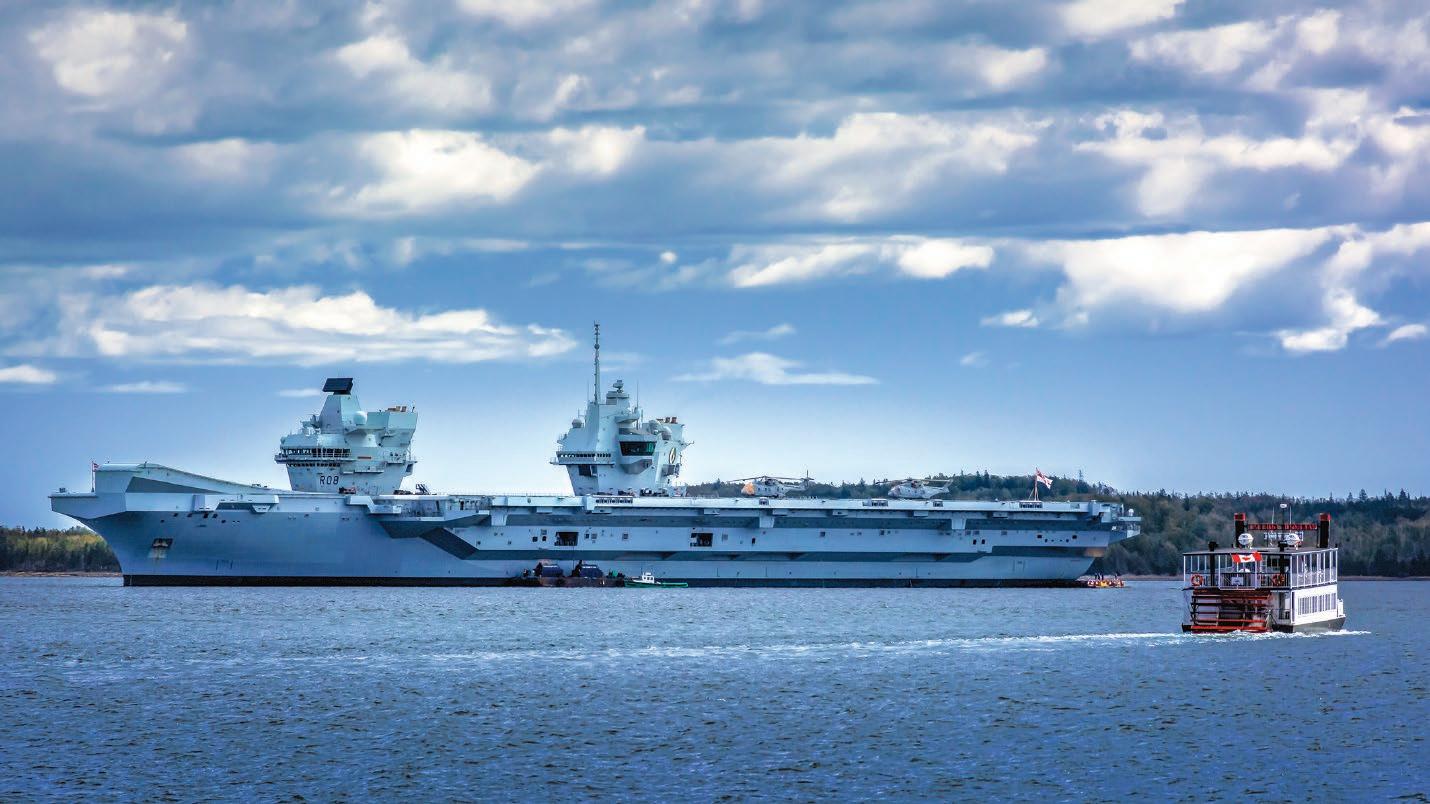
References:
1 BAE Systems https://bit.ly/3Oazke8
2 NATO https://bit.ly/43AKz5e
3 LHARRIS: ‘Understanding Electronic Warfare’ https://bit.ly/3Otni0A
The Systems Themselves Need to be Secure
Electronic warfare, in its many and evolving forms, is the future for warfare and nowhere more so than at sea. But, for all of its power, an electronic warfare fighting unit will still be vulnerable to a range of threats. It seems that, as the technology evolves, it will play a key role in protecting the physical integrity of the ship on which it is housed. But electronic functions are not only subject to traditional warfare threats, they can also be compromised if an enemy is able to penetrate their software, break into their communications and disrupt or distort their operations. It is therefore also a key factor in future developments that, whatever capabilities a naval vessel might have, they are protected from any electronic attack because, as they are so integral to modern warfare, their vulnerability would also be the ship’s vulnerability. Total security and safeguarding are an absolute priority.
4 Cranfield University: Prospectus for ‘Communications Electronic Warfare’ https://www.cranfield.ac.uk/courses/short/defence-and-security/communications-electronic-warfare
5 Global Defence Technology https://defence.nridigital.com/global_defence_technology_jan22/ew_technology_trends
6 Lloyd’s List: ‘Ethical hacker says ships are wide open to cyber-attack’ Declan Bush https://lloydslist.maritimeintelligence.informa.com/LL1136933/Ethical-hacker-says-ships-are-wide-open-to-cyber-attack
7 Aljundi: ‘Electronic Warfare on Warships; threats and countermeasures’ https://www.aljundi.ae/en/studies-and-analysis/electronic-warfare-on-warships-threats-countermeasures/
8 Control Engineering The best cable management strategy is foresight in selecting components https://www.controleng.com/articles/the-best-cable-management-strategy-is-foresight-in-selecting-components/
9 Military + Aerospace Electronics: ‘Royal Navy to boost electronic warfare (EW), anti-ship missile defense capability on U.K. surface warships’ https://www.militaryaerospace.com/sensors/article/14214238/electronic-warfare-ew-antiship-missile-defense-surface-warshipsaddress
10 TNO https://www.tno.nl/en/safe/protection-munitions-weapons/naval-ship-vulnerability-protection/
11 Thales: ‘Naval Self-protection’
https://www.thalesgroup.com/en/naval-self-protection
12 Royal Navy https://bit.ly/43IOLzT
13 Royal Navy, Type 45 Destroyer
https://www.royalnavy.mod.uk/the-equipment/ships/destroyers/daring-class
14 Defense Advancement https://bit.ly/474XzCV
15 Atlantis Press https://www.atlantis-press.com/proceedings/iccmcee-15/25839555
16 Naval Post: ‘The cyber threat in Naval Warfare’ https://navalpost.com/the-cyber-threat-in-naval-warfare/
17 Warrior Maven Center for Military Modernization https://warriormaven.com/sea/new-navy-electronic-warfare-tech-can-save-ships-stop-attacking-missiles
PROTECTING NAVAL SHIPS FROM EMP AND EMI WWW.GLOBALBUSINESSMEDIA.ORG | 13
The reality for future conflict is that, whoever has control of the electromagnetic spectrum has the best chance of winning in combat conditions. Electronic warfare capabilities are now at the leading edge of preparing for future conflicts
UK NAVY AIRCRAFT CARRIER HMS QUEEN ELIZABETH
Notes:
PROTECTING NAVAL SHIPS FROM EMP AND EMI 14 | WWW.GLOBALBUSINESSMEDIA.ORG
















